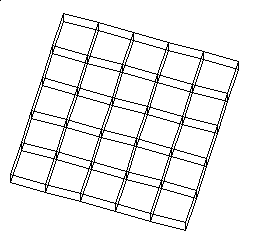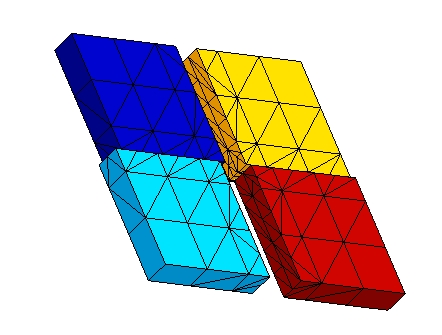5. C modeling#
5.1. Characteristics of modeling#
It is the same modeling as modeling A, but in \(\mathrm{3D}\). The intersection is constructed in the same way.
5.2. Characteristics of the mesh#
The mesh, which comprises 25 cells of the HEXA8 type, is represented in FIG. 5.2-a.

Figure 5.2-a: The C modeling mesh
5.3. Tested sizes and results#
The quantities tested are identical to those presented for modeling A. Tests on DZ are added.
Identification |
Reference |
Reference type |
Precision |
10^ -12% |
|
DEPZON_1 |
DX |
MIN |
-0.25 |
“ANALYTIQUE” |
|
MAX |
-0.25 |
“ANALYTIQUE” |
10^ -12% |
||
DY |
MIN |
0 |
“ANALYTIQUE” |
10^ -12% |
|
MAX |
0 |
“ANALYTIQUE” |
10^ -12% |
||
DEPZON_2 |
DX |
MIN |
-0.5 |
“ANALYTIQUE” |
10^ -12% |
MAX |
-0.5 |
“ANALYTIQUE” |
10^ -12% |
||
DY |
MIN |
0 |
“ANALYTIQUE” |
10^ -12% |
|
MAX |
0 |
“ANALYTIQUE” |
10^ -12% |
||
DEPZON_3 |
DX |
MIN |
0.75 |
“ANALYTIQUE” |
10^ -12% |
MAX |
0.75 |
“ANALYTIQUE” |
10^ -12% |
||
DY |
MIN |
0 |
“ANALYTIQUE” |
10^ -12% |
|
MAX |
0 |
“ANALYTIQUE” |
10^ -12% |
||
DEPZON_4 |
DX |
MIN |
0.75 |
“ANALYTIQUE” |
10^ -12% |
MAX |
0.75 |
“ANALYTIQUE” |
10^ -12% |
||
DY |
MIN |
0 |
“ANALYTIQUE” |
10^ -12% |
|
MAX |
0 |
“ANALYTIQUE” |
10^ -12% |
||
Table 5.3-1
The deformation is represented in FIG. 5.4-a.

Figure 5.4-a: Deformed structure.
We test the value of \({E}^{e}\) produced by the POST_ERREUR operator.
Identification |
Reference type |
Reference value |
Ee |
“ANALYTIQUE” |
0 |
We test the value of \({\Vert u\Vert }_{{L}^{2}}\) produced by the POST_ERREUR operator.